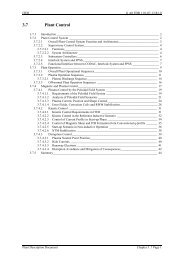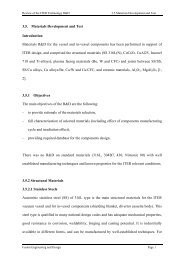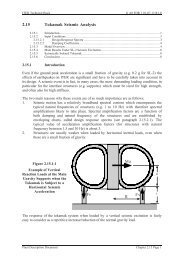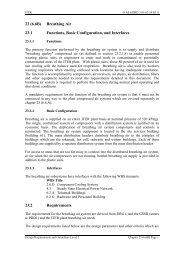3.1 Tritium Plant and Detritiation - General Atomics Fusion Group
3.1 Tritium Plant and Detritiation - General Atomics Fusion Group
3.1 Tritium Plant and Detritiation - General Atomics Fusion Group
- No tags were found...
You also want an ePaper? Increase the reach of your titles
YUMPU automatically turns print PDFs into web optimized ePapers that Google loves.
ITER G A0 FDR 1 01-07-13 R1.0rooms in the hot cell <strong>and</strong> the radwaste buildings, where the relevant HVAC isolation valvesare closed.Radwaste BuildingEnhancedDetritation FlowRed Zone 1-04Red Zone 1-11Red Zone 1-12HC-ADSAmber ZoneRoomsDifferentialPressure ControlFlowHC-VDSExhaustRooms in 4th FloorRooms in 3rd FloorRooms in 2nd FloorRooms in 1st FloorRed zone total room volume: 8,400 m 3Amber zone total room volume: 2,700 m 3BlowerSolid lines: Normal operationDashed line: St<strong>and</strong>byP/FH/FH/CC/CP/FP/FH/FH/CC/CP/FP/FH/FH/CC/CP/FBlowerExhaust Fresh Air Exhaust Fresh AirExhaustFresh AirH/C : Heating CoilC/C: Cooling CoilP/F: Pre FilterH/F: HEPA Filter: Isolation ValveFigure <strong>3.1</strong>-7Hot Cell <strong>and</strong> Radwaste Buildings - Confinement <strong>and</strong><strong>Detritiation</strong> System ConfigurationThe hot cell atmosphere detritiation system (capacity 4,500 m 3 /h) is manifolded to all redzone rooms to control the air flow rate required in each room depending on their operationstates. The achievable room air HTO concentration during occupancy by the maximumnumber of divertor cassettes (estimated tritium outgassing rate ~ 18 Ci/h) is 500 DAC(Derived Air Concentration: unprotected exposure to 1 DAC = 10 µSv/h), or 1.6 x10 8 Bq/m 3 .The reduction rate of the HTO concentration after removal of divertor cassettes or othertritium source terms from the room depends on the decontamination characteristics of thewall surface, <strong>and</strong> based on recent R&D results, the tritium concentration can be lowered to 1DAC within approximately 5 days using the atmosphere detritiation system at full capacity.Saturated molecular sieve beds in these detritiation systems are regenerated by a hot celldedicated regeneration system. The recovered condensate from the regeneration system <strong>and</strong>the HVAC is sent to the tritiated water holding tanks system located in the tritium building ina manner similar to that for the tritium plant systems.In order to reduce the generation rate of tritiated water from hot cell operation, minimizationof the leakage rate in the building walls, doors <strong>and</strong> other penetrations is being investigated.The tentative estimate of water generation based on the present design parameters (roomvolume, leak tightness, humidity <strong>and</strong> temperatures) is ~ 0.3 m 3 /d.<strong>Plant</strong> Description Document Chapter <strong>3.1</strong> Page 16








